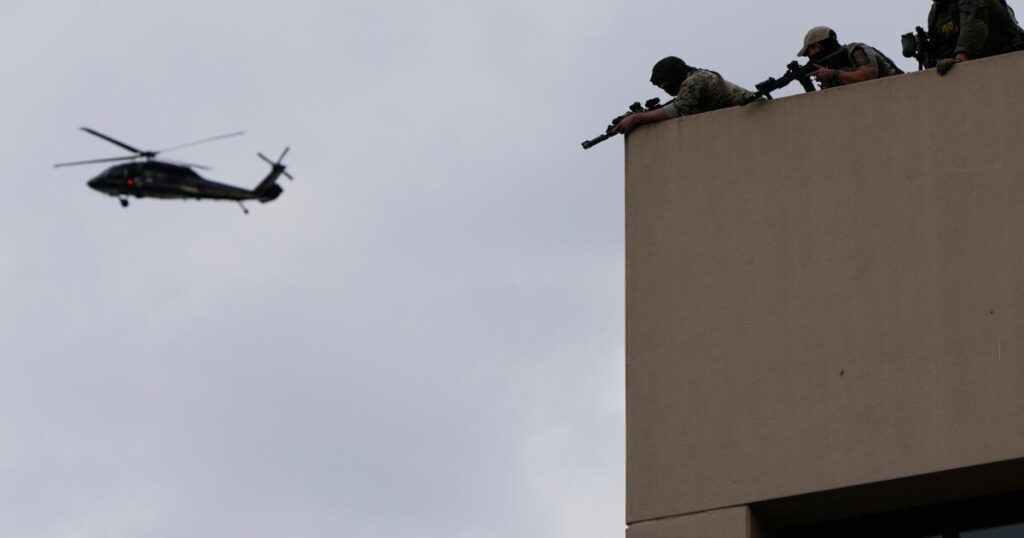PORTLAND, Ore. — A federal judge in Oregon temporarily blocked the Trump administration from deploying the National Guard in Portland, ruling Saturday in a lawsuit brought by the state and city.
U.S. District Judge Karin Immergut issued the order pending further arguments in the case. She said that the relatively small protests the city has seen did not justify the use of federalized forces and that allowing the deployment could harm Oregon’s state sovereignty.
“This country has a longstanding and foundational tradition of resistance to government overreach, especially in the form of military intrusion into civil affairs,” Immergut wrote. She later continued, “This historical tradition boils down to a simple proposition: this is a nation of Constitutional law, not martial law.”
State and city officials sued to stop the deployment last week, one day after the Trump administration announced that 200 Oregon National Guard troops would be federalized to protect federal buildings. The president called the city “war-ravaged.”
Oregon officials said that characterization was ludicrous. The U.S. Immigration and Customs Enforcement building in the city has been the site of nightly protests that typically drew a couple dozen people in recent weeks before the deployment was announced.
Generally speaking the president is allowed “a great level of deference” to federalize National Guard troops in situations where regular law enforcement forces are not able to execute the laws of the United States, the judge said, but that has not been the case in Portland.
Plaintiffs were able to show that the demonstrations at the immigration building were not significantly violent or disruptive ahead of the president’s order, the judge wrote, and “overall, the protests were small and uneventful.”
“The President’s determination was simply untethered to the facts,” Immergut wrote.
After the ruling, White House spokesperson Abigail Jackson said that “President Trump exercised his lawful authority to protect federal assets and personnel in Portland following violent riots and attacks on law enforcement — we expect to be vindicated by a higher court.”
Trump has deployed or threatened to deploy troops in several U.S. cities, particularly ones led by Democrats, including Los Angeles, Washington, Chicago and Memphis, Tenn. Speaking Tuesday to U.S. military leaders in Virginia, he proposed using cities as training grounds for the armed forces, alarming many military analysts.
Last month a federal judge ruled that the president’s deployment of some 4,700 National Guard soldiers and Marines in Los Angeles this year was illegal, but he allowed the 300 who remain in the city to stay as long as they do not enforce civilian laws. The Trump administration appealed, and an appellate panel has put the lower court’s block on hold while it moves forward.
The Portland protests have been limited to a one-block area in a city that covers about 145 square miles and has about 636,000 residents.
The protests grew somewhat following the Sept. 28 announcement of the Guard deployment. The Portland Police Bureau, which has said it does not participate in immigration enforcement and intervenes in the protests only if there is vandalism or criminal activity, arrested two people on assault charges. A peaceful march earlier that day drew thousands to downtown and saw no arrests, police said.
On Saturday, before the ruling was released, roughly 400 people marched to the ICE facility. The crowd included people of all ages and races, families with children and older people using walkers. Federal agents responded with chemical crowd-control munitions, including tear gas canisters and less-lethal guns that sprayed pepper balls. At least six people were arrested as the protesters reached the ICE building.
During his first term, Trump sent federal officers to Portland over the objections of local and state leaders in 2020 during long-running racial justice protests after George Floyd’s murder by Minneapolis police. The administration sent hundreds of agents for the stated purpose of protecting the federal courthouse and other federal property from vandalism.
That deployment antagonized demonstrators and prompted nightly clashes. Federal officers fired rubber bullets and used tear gas.
Viral videos captured federal officers arresting people and hustling them into unmarked vehicles. A report by the Department of Homeland Security’s inspector general found that while the federal government had legal authority to deploy the officers, many of them lacked the training and equipment necessary for the mission.
The government agreed this year to settle an excessive-force lawsuit brought by the American Civil Liberties Union by compensating several plaintiffs for their injuries.
Rush and Boone write for the Associated Press and reported from Portland and Boise, Idaho, respectively. AP writer Josh Boak in Washington contributed to this report.
